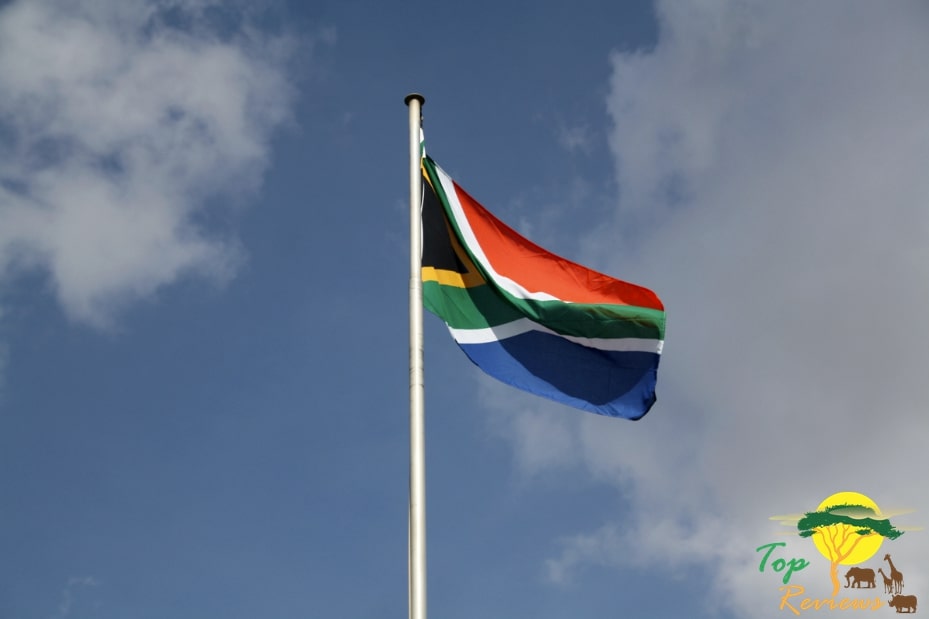Categories > Guides and Tips

What’s The Meaning Behind the South African Flag?
The flag of South Africa plays a big part in the nation’s history. As you probably learned during your first years in school, a national flag represents the country’s values, beliefs, and stories.
So, what does the South African flag tell us about this nation? Read on to find out more.
What Does the South African Flag Stand For?
The flag of South Africa symbolises unity in diversity. This is inspired by the National Coat of Arms’ Khoisan motto “!ke e:/xarra //ke”, which translates to “diverse people unite”.
The country’s previous flag was redesigned and adopted in 1994 to embody the country’s emerging democracy.
The designer of the flag, State Herald Frederick G. Brownell, specifically said that the colours used and the overall design does not have a significant meaning.
Instead, the flag is intended to allow people from different cultural and ethnic backgrounds to identify with the flag and form their own meaning.
However, there are several interpretations that have been suggested and accepted by many. Below are some examples of assumed meaning behind the flag’s colours:
| Colour | Meaning / Representation |
| Green | Fertility of the lands |
| Black | Native African community |
| White | White community; harmony and peace between Natives and Europeans |
| Gold | Country’s rich mineral resources |
| Red | Bloodshed and South Africa’s struggle for independence |
| Blue | The sky and the endless opportunities it symbolises |
The “Y” shape in the middle of the flag is also often described as a depiction of the “convergence” of a unified nation.
South Africa Flag: Colour Specifications

The table below shows the colour specifications as they are used in the national flag and as specified by the South African Government.
| Colour | Textile colour | Pantone equivalent |
| Green | CKS 42 c Spectrum green | 3415 c |
| Black | CKS 401 c Blue black | |
| White | CKS 701 c National flag white | |
| Gold | CKS 724 c Gold yellow | 1235 c |
| Red | CKS 750 c Chilli red | 179 c |
| Blue | CKS 762 c National flag blue | Reflex blue c |
It’s important to pay attention to the colour shades used, particularly for red, which specifically uses chilli red. South Africa is one of the leading consumers and producers of chilli.
Natives use it for flavouring and coming up with different hot sauces. You won’t be surprised to taste this spice in many dishes in chicken restaurants or even fast food restaurants.
The national flag’s design is also unmistakeably influenced by history. The colours black, yellow, and green were used from the ruling ANC party’s flag, while red, white, and blue are from the European colonists as well as the old Boer republics.
The national flag that South Africa currently uses wasn’t always the flag used to represent the country.
South African Flag Changes
The Union of South Africa’s first national flag was adopted in 1928.

The Netherlands’ Prinsevlag, an orange-white-blue tricolour flag, was used as the basis of the flag but South Africa distinguished theirs by putting miniature icons of the British Union Jack, Orange Free State’s and Transvaal’s flags.
Choosing the Prinsevlag as the basis of the Union’s flag was influenced by the belief that it was the first flag that was raised on South African soil.
South Africa faced a referendum in 1960 and was declared a republic in 1961. Since then, the flag was viewed as a symbol of apartheid; however, the nation’s flag remained unchanged until 1994.
The apartheid in South Africa ended in 1990. It was also then that Nelson Mandela was released from prison and there was a motion to change South Africa’s national flag.
In 1993, the National Symbols Commission called for a nationwide public competition to submit suggested designs, receiving more than 7,000. From those only six were presented to the public and the Negotiating Council, but none were chosen.
The following year, State Herald Frederick G. Brownell submitted a design for an interim flag for South Africa’s first fully inclusive elections and for Nelson Mandela’s inauguration.
The design was acknowledged and has been the nation’s national flag since then, and there’s no movement yet to have it changed – although it was just meant to be a temporary symbol.





